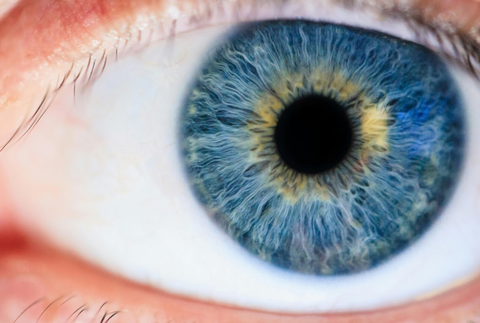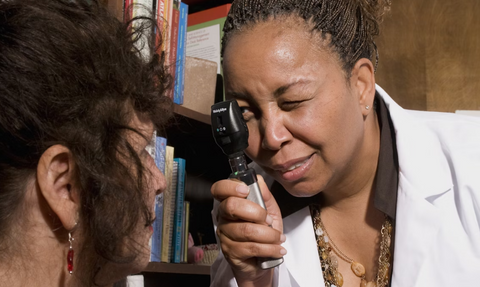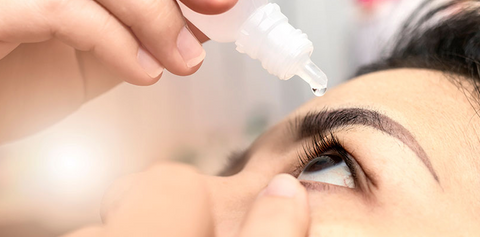Dry eyes can be a persistent and uncomfortable issue for many individuals, impacting their daily activities and overall quality of life. While various treatments exist to alleviate symptoms, such as artificial tears and lifestyle adjustments, some people wonder if wearing glasses can provide relief.
In this blog post, we'll delve into whether glasses can indeed help alleviate the discomfort associated with dry eyes and explore additional strategies for maintaining optimal eye health and comfort.

Understanding Dry Eyes
Dry eye syndrome, also known as keratoconjunctivitis sicca, is a common condition characterized by inadequate tear production or poor tear quality, leading to a range of uncomfortable symptoms. Tears are essential for maintaining the health and lubrication of the ocular surface, and any disruption in their production or composition can result in dry eyes.
One of the primary causes of dry eye syndrome is insufficient tear production by the lacrimal glands, which are responsible for producing tears. Tears consist of a complex mixture of water, oils, mucus, and proteins, each playing a crucial role in nourishing and protecting the cornea and conjunctiva. When the lacrimal glands fail to produce enough tears, the ocular surface becomes inadequately lubricated, leading to discomfort and irritation.
Another contributing factor to dry eye syndrome is poor tear quality, often associated with abnormalities in the composition of tears. Tears are composed of three main layers: the aqueous layer, the lipid layer, and the mucin layer. Each layer contributes to the stability and lubricating properties of tears. However, disruptions in the balance of these components can result in tear film instability, leading to rapid evaporation and subsequent dryness of the ocular surface.

What Causes Dry Eyes
Several factors can contribute to the development or exacerbation of dry eye syndrome. Age is a significant risk factor, as tear production tends to decrease with age, particularly among older adults.
Environmental conditions, such as low humidity, wind, smoke, and air conditioning, can also contribute to dry eye symptoms by accelerating tear evaporation and increasing ocular surface dryness.
Certain medications, including antihistamines, decongestants, antidepressants, and hormonal therapies, can cause or worsen dry eye symptoms by reducing tear production or altering tear composition.
Additionally, systemic health conditions like autoimmune diseases (e.g., Sjögren's syndrome, rheumatoid arthritis), diabetes, thyroid disorders, and vitamin deficiencies can affect tear production and quality, leading to dry eye symptoms.
Furthermore, lifestyle factors such as prolonged screen time, excessive use of digital devices, and inadequate blinking can contribute to dry eye syndrome by disrupting normal tear dynamics and exacerbating ocular surface dryness.
Contact lens wearers are also at an increased risk of developing dry eyes due to reduced oxygen permeability and increased tear evaporation associated with lens wear.

How Glasses Can Help
While glasses may not directly treat the underlying causes of dry eyes, they can offer several benefits for individuals experiencing this condition.
One way glasses can help is by providing a barrier that shields the eyes from environmental irritants, such as wind, dust, and pollen, which can exacerbate dry eye symptoms. Additionally, certain types of glasses, such as wraparound or oversized frames, can help minimize exposure to air drafts, reducing the evaporation of tears and helping to maintain moisture on the ocular surface.
Glasses with specialised lens coatings, such as anti-reflective or blue light-filtering coatings, can help enhance visual comfort for individuals with dry eyes. Anti-reflective coatings reduce glare and reflections from digital screens and artificial lighting, while blue light-filtering coatings can help reduce eye strain associated with prolonged screen time, which can worsen dry eye symptoms.
Choosing the Right Frames and Lenses
When selecting glasses for dry eye relief, it's essential to consider factors such as frame style, lens material, and lens coatings.
Opting for lightweight frames with a comfortable fit can minimize pressure on the nose and temples, reducing the risk of discomfort during extended wear. Additionally, choosing lenses with a high water content, such as those made from polycarbonate or Trivex, can help retain moisture and prevent evaporation, promoting greater comfort for individuals with dry eyes.
Incorporating lens coatings like anti-reflective, anti-glare, and photochromic coatings can enhance visual clarity and reduce eye strain, contributing to overall eye comfort. Anti-reflective coatings, in particular, help minimize glare and reflections, while photochromic coatings adjust to changing light conditions, providing optimal visual acuity in various environments.
Additional Strategies for Dry Eye Relief
While wearing glasses can offer relief for dry eyes, it's essential to adopt a comprehensive approach to managing this condition.
Alongside wearing glasses, individuals can implement lifestyle modifications and home remedies to alleviate symptoms and promote ocular health. Some effective strategies include:
-
Using a humidifier: Adding moisture to the air can help alleviate dry eye symptoms, especially in indoor environments with low humidity levels.

- Practising the 20-20-20 rule: Taking regular breaks during screen time to rest the eyes can reduce strain and prevent exacerbation of dry eye symptoms.
-
Maintaining good eyelid hygiene: Cleaning the eyelids and lashes regularly can help prevent blockage of the oil glands, reducing the risk of meibomian gland dysfunction, a common cause of dry eye syndrome.
-
Staying hydrated: Drinking an adequate amount of water throughout the day can help ensure proper tear production and maintain ocular surface hydration.

- Seeking professional guidance: Consulting an eye care professional for a comprehensive eye exam and personalized treatment plan is essential for managing dry eye syndrome effectively. They can recommend prescription medications, in-office procedures, or advanced treatments like punctal plugs or intense pulsed light therapy, depending on the severity of the condition.

- Lubricating eye drops: Adding eye drops into your daily routine can provide relief from dry eyes. These over-the-counter drops can help supplement natural tear production, reducing discomfort and irritation. It's essential to choose preservative-free eye drops and follow the recommended usage instructions. Adding this simple step to your eye care routine can contribute to overall ocular comfort and complement other strategies in managing dry eye symptoms.
While wearing glasses may not be a cure-all for dry eyes, they can provide valuable relief by protecting the eyes from environmental irritants and minimizing visual strain.
Au Revoir,
PRET A VOIR











0 comments